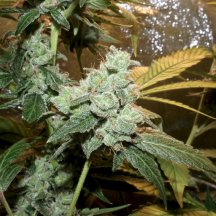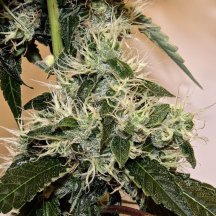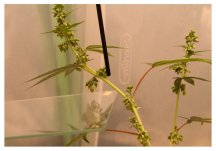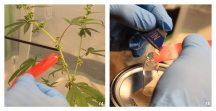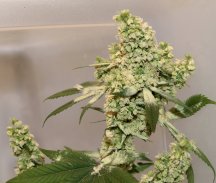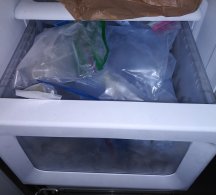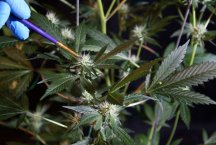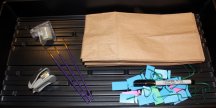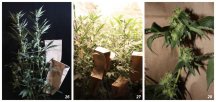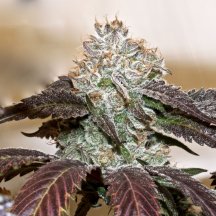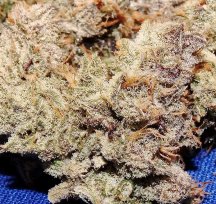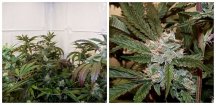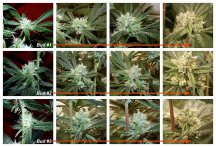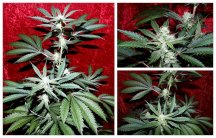-
CHUCKERSPARADISE NEWS: Click HERE to read.
Schwaggy P's Random Stuff
- Thread starter Schwaggy P
- Start date
Side-by-side of Chem D pollinated in soil and hydro. The differences you can see between the two methods is pretty consistent in other side-by-sides I've grown. The soil plant is at day 42, and the hydro plant is at day 61.
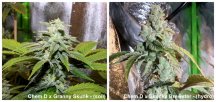
Here's a shot of the hydro Chem D's side nuggetry. The pollinated Chem '91 skva can be seen in the background.
Main Cola
Chuckers Paradise
They all look great ,,I’m really liking that Chocolate DieselDay 45 of flower
Thank you, Useful Seeds offers Chocolate Diesel S1 beans.They all look great ,,I’m really liking that Chocolate Diesel
I would like to share my method of pollen collecting and targeted single branch pollination. If you decide to replicate this process for yourself, please be warned that having a male dropping pollen requires great care. I have organized this information into 3 sections: Flowering the Male, Collecting/Storing Pollen, and Pollinating a Single Branch.
FLOWERING THE MALE
I usually take clones of males to keep their size manageable. Once they are rooted, I plant them in a 3” square pot and put them in a clear storage tote (pic 1). You will want to keep the tote lid slightly ajar to allow for air exchange.
Where to keep him depends on whether you have a free tent, separate veg space, or just another room with sunlight. For times when all tents are taken, I keep the male in my veg area (pic 2). It is important to remember that he will be separated from the flowering females.
⚠ In the corner of your veg room or peripheral splash over light is just fine to trigger the male. There’s no need to put him 3” beneath a 1000W DE, I’ve flowered males from the spillover light of a T5.
If you have a single tent with females flowering, the ambient light in another room is enough to accomplish our task.
The 12hr dark cycle is achieved by placing a box over the male’s clear tote (pic 3). This 12/12 box covering will trigger and maintain flowering through the entire process until you’ve collected enough pollen.
⚠ Make sure the box is large enough to cover your storage tote before you begin.
If you are triggering a male for a one-time pollination without storing pollen, then timing will be important. Males will usually develop flowers pretty quickly relative to their female flower setting counterparts. Since we want our females to have a decent flowerset to accept pollen, we have to give her some time to develop them. With most strains, weeks 3-4 will give us the best window to have both nice flower setting and early enough to give the seeds time to mature.
⚠ Don’t trigger your male until about day 10 of flower for your females. This gives females the head start to ensure there will be nice sized buds to give you seeds, as well as not have to deal with and worry about a male dumping tons of pollen too early.
This 12/12 box cycle will continue for the duration of pollen collection.
⚠ You want to approach most things in this process slowly and carefully. There is no extra credit for speed. Being gentle and deliberate with him will ensure any pollen stays within the tote. Pretend you’re doing tai chi at the senior center when you interact with him.
As you gain confidence and success with this process, you can flower multiple males simultaneously (pic 4).
Keep in mind, the goal here is to be aware of his maturity in order to collect pollen long before he creates dust storms. At first, his flowers will be small balls (pic 5) that are not much of a threat to your females at this point. As they begin to develop, you will notice that they cluster and start to hang (pic 6). Usually this timeline window can be from 10-20 days. As the male flowers begin to individualize from the clusters you are now on pollen watch.
⚠ This is the point at which you will need to be very careful about moving him around and watering him.
Once you begin to see the male flowers open, the yellowish anthers will be visible (pic 7) but not drop pollen just yet. The pollen is only hours away at this point, so remain vigilant. If you try to collect pollen as soon as the male flower opens, you’ll find no pollen freely drops, so wait until you see the anthers go from a tight smooth sheen, to bloated matte yellow (pic 8 ).
If you find that you are having issue timing the pollen drop, you can wait until one of the flowers releases pollen onto a leaf below (pic 9).
The male flowers will reach maturity at different rates, which we can use to our advantage. The older male flowers will be first to drop and keep in mind we are only needing a few flowers worth of pollen in order to pollinate multiple single branches. By collecting the first few pollen drops, we are containing the threat of stray pollen.
FLOWERING THE MALE
I usually take clones of males to keep their size manageable. Once they are rooted, I plant them in a 3” square pot and put them in a clear storage tote (pic 1). You will want to keep the tote lid slightly ajar to allow for air exchange.
Where to keep him depends on whether you have a free tent, separate veg space, or just another room with sunlight. For times when all tents are taken, I keep the male in my veg area (pic 2). It is important to remember that he will be separated from the flowering females.
⚠ In the corner of your veg room or peripheral splash over light is just fine to trigger the male. There’s no need to put him 3” beneath a 1000W DE, I’ve flowered males from the spillover light of a T5.
If you have a single tent with females flowering, the ambient light in another room is enough to accomplish our task.
The 12hr dark cycle is achieved by placing a box over the male’s clear tote (pic 3). This 12/12 box covering will trigger and maintain flowering through the entire process until you’ve collected enough pollen.
⚠ Make sure the box is large enough to cover your storage tote before you begin.
If you are triggering a male for a one-time pollination without storing pollen, then timing will be important. Males will usually develop flowers pretty quickly relative to their female flower setting counterparts. Since we want our females to have a decent flowerset to accept pollen, we have to give her some time to develop them. With most strains, weeks 3-4 will give us the best window to have both nice flower setting and early enough to give the seeds time to mature.
⚠ Don’t trigger your male until about day 10 of flower for your females. This gives females the head start to ensure there will be nice sized buds to give you seeds, as well as not have to deal with and worry about a male dumping tons of pollen too early.
This 12/12 box cycle will continue for the duration of pollen collection.
⚠ You want to approach most things in this process slowly and carefully. There is no extra credit for speed. Being gentle and deliberate with him will ensure any pollen stays within the tote. Pretend you’re doing tai chi at the senior center when you interact with him.
As you gain confidence and success with this process, you can flower multiple males simultaneously (pic 4).
Keep in mind, the goal here is to be aware of his maturity in order to collect pollen long before he creates dust storms. At first, his flowers will be small balls (pic 5) that are not much of a threat to your females at this point. As they begin to develop, you will notice that they cluster and start to hang (pic 6). Usually this timeline window can be from 10-20 days. As the male flowers begin to individualize from the clusters you are now on pollen watch.
⚠ This is the point at which you will need to be very careful about moving him around and watering him.
Once you begin to see the male flowers open, the yellowish anthers will be visible (pic 7) but not drop pollen just yet. The pollen is only hours away at this point, so remain vigilant. If you try to collect pollen as soon as the male flower opens, you’ll find no pollen freely drops, so wait until you see the anthers go from a tight smooth sheen, to bloated matte yellow (pic 8 ).
If you find that you are having issue timing the pollen drop, you can wait until one of the flowers releases pollen onto a leaf below (pic 9).
The male flowers will reach maturity at different rates, which we can use to our advantage. The older male flowers will be first to drop and keep in mind we are only needing a few flowers worth of pollen in order to pollinate multiple single branches. By collecting the first few pollen drops, we are containing the threat of stray pollen.
Main Cola
Chuckers Paradise
Thank you. I think I’ll have to pick some upThank you, Useful Seeds offers Chocolate Diesel S1 beans.
You're welcome.Thank you. I think I’ll have to pick some up
Main Cola
Chuckers Paradise
This is such a great write up. Thank you for sharing thisI would like to share my method of pollen collecting and targeted single branch pollination. If you decide to replicate this process for yourself, please be warned that having a male dropping pollen requires great care. I have organized this information into 3 sections: Flowering the Male, Collecting/Storing Pollen, and Pollinating a Single Branch.
FLOWERING THE MALE
I usually take clones of males to keep their size manageable. Once they are rooted, I plant them in a 3” square pot and put them in a clear storage tote (pic 1). You will want to keep the tote lid slightly ajar to allow for air exchange.
Where to keep him depends on whether you have a free tent, separate veg space, or just another room with sunlight. For times when all tents are taken, I keep the male in my veg area (pic 2). It is important to remember that he will be separated from the flowering females.
⚠ In the corner of your veg room or peripheral splash over light is just fine to trigger the male. There’s no need to put him 3” beneath a 1000W DE, I’ve flowered males from the spillover light of a T5.
If you have a single tent with females flowering, the ambient light in another room is enough to accomplish our task.
The 12hr dark cycle is achieved by placing a box over the male’s clear tote (pic 3). This 12/12 box covering will trigger and maintain flowering through the entire process until you’ve collected enough pollen.
⚠ Make sure the box is large enough to cover your storage tote before you begin.
If you are triggering a male for a one-time pollination without storing pollen, then timing will be important. Males will usually develop flowers pretty quickly relative to their female flower setting counterparts. Since we want our females to have a decent flowerset to accept pollen, we have to give her some time to develop them. With most strains, weeks 3-4 will give us the best window to have both nice flower setting and early enough to give the seeds time to mature.
⚠ Don’t trigger your male until about day 10 of flower for your females. This gives females the head start to ensure there will be nice sized buds to give you seeds, as well as not have to deal with and worry about a male dumping tons of pollen too early.
This 12/12 box cycle will continue for the duration of pollen collection.
⚠ You want to approach most things in this process slowly and carefully. There is no extra credit for speed. Being gentle and deliberate with him will ensure any pollen stays within the tote. Pretend you’re doing tai chi at the senior center when you interact with him.
As you gain confidence and success with this process, you can flower multiple males simultaneously (pic 4).
Keep in mind, the goal here is to be aware of his maturity in order to collect pollen long before he creates dust storms. At first, his flowers will be small balls (pic 5) that are not much of a threat to your females at this point. As they begin to develop, you will notice that they cluster and start to hang (pic 6). Usually this timeline window can be from 10-20 days. As the male flowers begin to individualize from the clusters you are now on pollen watch.
⚠ This is the point at which you will need to be very careful about moving him around and watering him.
Once you begin to see the male flowers open, the yellowish anthers will be visible (pic 7) but not drop pollen just yet. The pollen is only hours away at this point, so remain vigilant. If you try to collect pollen as soon as the male flower opens, you’ll find no pollen freely drops, so wait until you see the anthers go from a tight smooth sheen, to bloated matte yellow (pic 8 ).
If you find that you are having issue timing the pollen drop, you can wait until one of the flowers releases pollen onto a leaf below (pic 9).
The male flowers will reach maturity at different rates, which we can use to our advantage. The older male flowers will be first to drop and keep in mind we are only needing a few flowers worth of pollen in order to pollinate multiple single branches. By collecting the first few pollen drops, we are containing the threat of stray pollen.
COLLECTING & STORING POLLEN
Now that our male has begun dropping pollen, we can start our collection. I like to use a piece of glass (taken from a dollar store picture frame) and a coffee stirrer to free and collect the pollen.
⚠ Make sure to kill any large air movers that may disturb this process. The only air circulators you may want going is an extraction fan that can create the negative pressure to keep any stray pollen inside of a tent.
You will position your glass under the flower that is ready to drop, and just slightly agitate it with the stirrer. A slight small nudge is all that you need to free the pollen (pic 10,11).
Then, you will slowly use a razor blade to transfer the pollen from your collection surface into a storage container (pic 12). I use narrow necked glass vials.
⚠ Remember: we only need to collect 3-4 male flowers worth of pollen to have several single branch pollinations.
If you have no intention of collecting pollen for future work, then this single pollen collection is all you need to dust some branches (pic 13). So at this point, the male’s job is done and we can dispose of him long before he starts to really open up and create a high risk for accidental pollination.
You can use any smooth surface to collect the pollen. When there are hard to reach male flowers, I switch to a plant tag for collection (pic 14,15), so just be creative with what you have.
⚠ When you trash the male, be sure to change your clothes and shower before going near the flowering females. While there won’t be much pollen this early, it’s better to be safe than sorry.
Sometimes, I like to let the male flower out for long periods for larger stores of pollen and to make sure he doesn’t hermie later in flower. You can see the risk factor for accidental pollination escalates quickly at the male’s later stages, as he dumps tons of pollen. Ideally, your male will be long gone before this can happen (unless you want it to happen )
With your collected pollen (pic 13), you have 2 choices:
The next day, you can cap your container and place it in a labeled bag with a small desiccant for long term storage. Make sure to include the date the pollen was collected so that viability can be tracked. I like to prepare single-use vials that have just enough pollen so that when I take out and use it, there is nothing left. I don’t have to worry about freezing and defrosting the same container.
⚠ I try to use up pollen within a year of its collection. As the viability begins to drop off, you’ll notice fewer pollinated flowers as you continue to use the pollen. You’ll want to refresh your pollen bank as you notice the reduction in viability.
You can keep your packaged pollen containers in the freezer until you are ready for pollination. I keep a drawer in the freezer full of various pollens. Whenever I have female plants that are ready for dusting, I can make several crosses without having to constantly juggle multiple flowering males.
Now that our male has begun dropping pollen, we can start our collection. I like to use a piece of glass (taken from a dollar store picture frame) and a coffee stirrer to free and collect the pollen.
⚠ Make sure to kill any large air movers that may disturb this process. The only air circulators you may want going is an extraction fan that can create the negative pressure to keep any stray pollen inside of a tent.
You will position your glass under the flower that is ready to drop, and just slightly agitate it with the stirrer. A slight small nudge is all that you need to free the pollen (pic 10,11).
Then, you will slowly use a razor blade to transfer the pollen from your collection surface into a storage container (pic 12). I use narrow necked glass vials.
⚠ Remember: we only need to collect 3-4 male flowers worth of pollen to have several single branch pollinations.
If you have no intention of collecting pollen for future work, then this single pollen collection is all you need to dust some branches (pic 13). So at this point, the male’s job is done and we can dispose of him long before he starts to really open up and create a high risk for accidental pollination.
You can use any smooth surface to collect the pollen. When there are hard to reach male flowers, I switch to a plant tag for collection (pic 14,15), so just be creative with what you have.
⚠ When you trash the male, be sure to change your clothes and shower before going near the flowering females. While there won’t be much pollen this early, it’s better to be safe than sorry.
Sometimes, I like to let the male flower out for long periods for larger stores of pollen and to make sure he doesn’t hermie later in flower. You can see the risk factor for accidental pollination escalates quickly at the male’s later stages, as he dumps tons of pollen. Ideally, your male will be long gone before this can happen (unless you want it to happen )
With your collected pollen (pic 13), you have 2 choices:
- If you’re doing just a few branch pollinations, the staggered timing of triggering the male, means your females are ready to be dusted and there is no need to worry about storing the pollen. You could move on to the section (Pollinating a Single Branch).
- If you would like to store the pollen, allow the container to dry overnight in a safe place away from fans. This allows any residual moisture to be purged for long-term storage.
The next day, you can cap your container and place it in a labeled bag with a small desiccant for long term storage. Make sure to include the date the pollen was collected so that viability can be tracked. I like to prepare single-use vials that have just enough pollen so that when I take out and use it, there is nothing left. I don’t have to worry about freezing and defrosting the same container.
⚠ I try to use up pollen within a year of its collection. As the viability begins to drop off, you’ll notice fewer pollinated flowers as you continue to use the pollen. You’ll want to refresh your pollen bank as you notice the reduction in viability.
You can keep your packaged pollen containers in the freezer until you are ready for pollination. I keep a drawer in the freezer full of various pollens. Whenever I have female plants that are ready for dusting, I can make several crosses without having to constantly juggle multiple flowering males.
POLLINATING A SINGLE BRANCH
Now that we have our pollen collected, we can pollinate females that are ready. You’ll need:
Choose a branch from the mid to lower section of your female that will receive light through the canopy (pic 17). Choosing a branch that is not tangled with others and has free range of motion will make this process easier.
Make sure the branch you choose and the buds you plan to pollinate will fit inside of your paper bag (pic 18 ).
Affix your tag to the chosen branch just below the last bud you can fit into your bag (pic 19). This will help you at harvest time to know how much of the branch to cut to separate from your sensi bud.
With all fans and air circulators turned off, you can begin the pollination process.
⚠ When using a freshly clean brush, the pollen will have a tendency to fall from the tip. Gently tap your brush into one of the targeted buds to get some resin on your brush BEFORE you collect the first bit of pollen onto the brush. That little bit of stickiness from the resin will make sure the pollen doesn’t fall from the brush.
We only need the tip of the brush to have pollen, this keeps the pollen within our control and is plenty to achieve our goal. Try to load your brush against the wall of the container first (pic 20). When you load the brush from the pollen pile, try to get just enough, no need to dive into the middle of the pollen (pic 21).
With your brush, slowly and gently poke your female flowers with the first few brush movements (pic22) this ensures the pollen payload isn’t flicked into the air by brushing it. Once you’ve done a few pokings around the bud, you can gently brush the pollen to “color –in” the bud.
⚠ A little goes a long way, so you really do not need more than 2-3 brush tips of pollen for each bud site. Don’t think you need tons of pollen because excess can cause accidental pollination if it goes airborne.
With the pollen fully dusted, the paper bag can be placed over the branch (pic 23). The corner of the bag is then folded over and stapled (pic 24). With the branch bagged, all you need to do is secure the bag, this will depend on your particular method of support (pic 25).
⚠ Make sure that the paper bag you choose does not have a wax coating on the inside. This coating can inhibit air exchange and cause problems.
With your female branches dusted and bagged (pic 26), you can return her to the flowering space (pic 27). The bag should remain on the branch for 5-7 days. After about a week, you can remove the bags and find a branch that is fully pollinated (pic 28 ).
⚠ If you are worried about stray pollen after the bag is removed, you can take the female out of the flower space, remove the bag, and lightly mist the branch with water to deactivate any stray pollen.
We will allow the females to finish their flower cycle and harvest as usual. During chop, I cut the seeded branches at the tag and hang them separately (pic 29). You can use different pollen on the same plant (different branches) to achieve multiple crosses using the same female.
Picture 29 shows 7 different crosses from one tent. When the branches have dried, you can shuck the seeds and allow them to dry/cure (pic 30). Each branch (depending on size and strain) can yield between 150-300 seeds, giving you a nice seed drop of your own creation.
Now that we have our pollen collected, we can pollinate females that are ready. You’ll need:
- Paper bags
- Tags
- Brushes
- Pollen
- Stapler
Choose a branch from the mid to lower section of your female that will receive light through the canopy (pic 17). Choosing a branch that is not tangled with others and has free range of motion will make this process easier.
Make sure the branch you choose and the buds you plan to pollinate will fit inside of your paper bag (pic 18 ).
Affix your tag to the chosen branch just below the last bud you can fit into your bag (pic 19). This will help you at harvest time to know how much of the branch to cut to separate from your sensi bud.
With all fans and air circulators turned off, you can begin the pollination process.
⚠ When using a freshly clean brush, the pollen will have a tendency to fall from the tip. Gently tap your brush into one of the targeted buds to get some resin on your brush BEFORE you collect the first bit of pollen onto the brush. That little bit of stickiness from the resin will make sure the pollen doesn’t fall from the brush.
We only need the tip of the brush to have pollen, this keeps the pollen within our control and is plenty to achieve our goal. Try to load your brush against the wall of the container first (pic 20). When you load the brush from the pollen pile, try to get just enough, no need to dive into the middle of the pollen (pic 21).
With your brush, slowly and gently poke your female flowers with the first few brush movements (pic22) this ensures the pollen payload isn’t flicked into the air by brushing it. Once you’ve done a few pokings around the bud, you can gently brush the pollen to “color –in” the bud.
⚠ A little goes a long way, so you really do not need more than 2-3 brush tips of pollen for each bud site. Don’t think you need tons of pollen because excess can cause accidental pollination if it goes airborne.
With the pollen fully dusted, the paper bag can be placed over the branch (pic 23). The corner of the bag is then folded over and stapled (pic 24). With the branch bagged, all you need to do is secure the bag, this will depend on your particular method of support (pic 25).
⚠ Make sure that the paper bag you choose does not have a wax coating on the inside. This coating can inhibit air exchange and cause problems.
With your female branches dusted and bagged (pic 26), you can return her to the flowering space (pic 27). The bag should remain on the branch for 5-7 days. After about a week, you can remove the bags and find a branch that is fully pollinated (pic 28 ).
⚠ If you are worried about stray pollen after the bag is removed, you can take the female out of the flower space, remove the bag, and lightly mist the branch with water to deactivate any stray pollen.
We will allow the females to finish their flower cycle and harvest as usual. During chop, I cut the seeded branches at the tag and hang them separately (pic 29). You can use different pollen on the same plant (different branches) to achieve multiple crosses using the same female.
Picture 29 shows 7 different crosses from one tent. When the branches have dried, you can shuck the seeds and allow them to dry/cure (pic 30). Each branch (depending on size and strain) can yield between 150-300 seeds, giving you a nice seed drop of your own creation.
Thanks, it's my pleasureThis is such a great write up. Thank you for sharing this
Thank you so much, I really appreciate that. My hope was to have a solid guide with visuals that adds the little tidbits that are usually learned through failure to save everyone the hassle. If you decide to give it a shot and have any questions, I'm glad to help.I have read info on this stuff alot. And this is by far the best, you just have a way of putting it all together so well. Great descriptions of the process and great pics to go along with them. You make it seem so easy.
Feva.
Really Active Member
Thanks Ive only done one intentional pollination think it was 2 years ago now Feb of 17 with the chocolate trip f2 from bodhi. I took the male on the left and hit my female trips for f3s I think it was about the same time Useful did his. I still have a nice amount of those in my seed stash. Just two days ago I got rid of a male of White shark X Aloha White Widow f2 now im kinda regretting it. lol

I grew out Useful's Chocolate Trip F4 and found a very frosty lady that is waiting for some future projects.Thanks Ive only done one intentional pollination think it was 2 years ago now Feb of 17 with the chocolate trip f2 from bodhi. I took the male on the left and hit my female trips for f3s I think it was about the same time Useful did his. I still have a nice amount of those in my seed stash. Just two days ago I got rid of a male of White shark X Aloha White Widow f2 now im kinda regretting it. lol
I had a Chem Kesey male that I tossed and regret. Now, I keep a cut of every male that gets used.
The biggest difference I experience is in the taste. The usual refrain is that hydro wins with yield, but soil wins with taste. I find that many soil grown flowers all have a similar "earthiness" to their taste, almost like you can taste the soil.Schwaggy, on your soil vs hydro side by sides. I see there are discernible growth differences between the two.It seems to more bud growth on the hydro side(expected). Outside of the visual differences,are there any differences in the final product?
If you were to have an earthy, kushy strain which draws from this section of the flavor palette, then the boosted nuances in this earthiness/soil can be interpreted as a great, "better" product when compared to the hydro product. If you are cultivating a more fruity/sweet strain that shines with a "cleaner" taste, then you might find the hydro grown to better showcase this as the boosted earthiness is mostly absent.
I have had a few cuts that express a heavy earthy/soil flavor in the hydro flowers. To me, this gives me a more clear picture as to the genetic flavor contribution since I can be assured that this experience is not a result of the growing medium.
There are some hydro friendly hybrid organic/synthetic additives that can mimic the soil taste, so you could impart that in hydro flowers if you were so inclined. Ultimately, there isn't a wild night/day difference in great runs of the same cut, but since this is such a subjective topic, I'm sure many will have differing opinions.
Last edited:
Cob_nUt
"Justa Ganja Lover"
Excellent response.I share the same view in this regards.Eh,I wouldn't have put it so eloquently tho.The biggest difference I experience is in the taste. The usual refrain is that hydro wins with yield, but soil wins with taste. I find that many soil grown flowers all have a similar "earthiness" to their taste, almost like you can taste the soil.
If you were to have a earthy, kushy strain which draws from this section of the flavor palette, then the boosted nuances in this earthiness/soil can be interpreted as a great, "better" product when compared to the hydro product. If you are cultivating a more fruity/sweet strain that shines with a "cleaner" taste, then you might find the hydro grown to better showcase this as the boosted earthiness is mostly absent.
I have had a few cuts that express a heavy earthy/soil flavor in the hydro flowers. To me, this gives me a more clear picture as to the genetic flavor contribution since I can be assured that this experience is not a result of the growing medium.
There are some hydro friendly hybrid organic/synthetic additives that can mimic the soil taste, so you could impart that in hydro flowers if you were so inclined. Ultimately, there isn't a wild night/day difference in great runs of the same cut, but since this is such a subjective topic, I'm sure many will have differing opinions.
Smell: cocoa powder, baking chocolate, dark chocolate, strawberries, berry
Taste: Crunch Berries (not sugary), slightly hashy, lingering dark chocolate exhale
Effect: starts with swollen eyes and slight raciness, calms into a functional heady indica after ~20-30mins. Overall duration ~1.5-2hrs
Growing:
Stretch: roughly doubled initial flowering height
Flowering Time: 58-63 days
Nutes: Moderate to Heavy feeder, she is a forgiving plant that can thrive in a wide range of nutrient concentrations.
Taste
When you first crack open a full jar of the Chocolate Covered Strawberries F2 (CCS), this dark/bitter baker’s chocolate immediately floods out of the crusted nugs. Hovering your nose over the jar and taking a long draw sniff reveals the berries just underneath the initially overwhelming cocoa aroma. The berry component has a light resemblance to fresh strawberries, but has been described by others as having a more generic berry (generic meaning not one particular type of berry) splash to the complex nose. Neither the chocolate nor berry has a sweet/sugary aspect, more of a bitter chocolate and natural berry qualities.
On the exhale, you definitely pick up berry flavoring. At first you think, “It’s like blueberries, strawberries, grape, raspberry...” and then it hits, Crunch Berries! She tastes like Cap’n Crunch Crunch Berries cereal. This resemblance to the cereal does not have the overly sweet/sugary aspect that the cereal has, but the flavoring is very similar. This mix of all things berry gives way to the dark cocoa hash foreshadowed in the smell. The chocolate taste lingers in your mouth after the berries. The CCS is able to produce this complex flavor profile long after the first “green hits” are a memory in your smoke session.
Effect
The first thing you notice after a few minutes is the heaviness of swelled eyelids. A tingling starts behind the eyes and a sense of “rush” begins to fill your chest. An uptick in heart rate makes you double take to make sure she’s still “indica”. The beginnings of raciness begin to take over for about 10-15mins as your body tries to acclimate to the huge chemical bath you just gave your brain. This subsides rather quickly leaving you in a spacey cloud of upbeat energetic relaxation. The CCS has a calming and mood-elevating characteristic.
She does not have an overwhelming couch-lock, but can definitely mellow you out. Her effect is one of a functional indica that would be a great midday smoke loosening you up without putting you to sleep. The CCS is a solid “good-time” smoke that is great for social situations either preparing you for them or accentuating a get-together.
Overall
The Chocolate Covered Strawberries F2 has a very enjoyable and complex aroma that truly does not disappoint. We can all rattle off many strains we’ve come across with very descriptive names that fall well short once smelled/tasted/experienced that you’d expect from such colorful, flavorful, bombastic names. This is one that lives up to the name.
She is a breeze to grow with great vigor. She can handle any training techniques and will begin to purple at about week 5-6 of flower. The CCS would be very kind to newer growers or those that prefer fewer headaches when growing as she can handle a wide range of feeding without throwing fits. Her shorter flowering time ensures a brisk end to an easy grow cycle.
Her genetic background is solidly indica but has expressed a great headiness, which makes for very functional daytime smoke. The CCS has great bag appeal and a generous coating of frost.
If you’re looking for complex flavorful cannabis that is easy to grow, rewards with a nice relaxing upbeat effect, and has cover girl appeal, look no further than the Chocolate Covered Strawberries F2.


